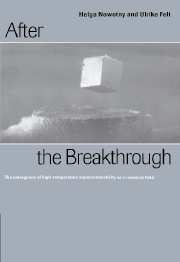Book contents
- Frontmatter
- Contents
- Acknowledgments
- 1 Introduction: the emergence of a new research field
- 2 The context of the discovery
- 3 Reconfiguring actors and knowledge: the organization of a new research field
- 4 Academic research, science policy, and the industrial connection: setting up national high-temperature superconductivity programs
- 5 Science and the media: newspapers and their “HTS story”
- 6 The innovation machinery of science: the case of HTS
- Appendix 1 Main events in the history of superconductivity before the discovery by Müller and Bednorz
- Appendix 2 Chronology of important events in high-temperature superconductivity in the early phase
- References
- Index
2 - The context of the discovery
Published online by Cambridge University Press: 02 December 2009
- Frontmatter
- Contents
- Acknowledgments
- 1 Introduction: the emergence of a new research field
- 2 The context of the discovery
- 3 Reconfiguring actors and knowledge: the organization of a new research field
- 4 Academic research, science policy, and the industrial connection: setting up national high-temperature superconductivity programs
- 5 Science and the media: newspapers and their “HTS story”
- 6 The innovation machinery of science: the case of HTS
- Appendix 1 Main events in the history of superconductivity before the discovery by Müller and Bednorz
- Appendix 2 Chronology of important events in high-temperature superconductivity in the early phase
- References
- Index
Summary
The discovery of materials that become superconducting at temperatures higher than previously observed or thought possible opened up a new research field. This chapter examines the individual, scientific, and institutional background of the discovery by Georg Müller and Alex Bednorz at IBM's Rüschlikon Laboratory in Zurich, Switzerland. The first section places the discovery in the context of the evolution, organization, and salient characteristics of the multidisciplinary field of materials science. Section 2.2 examines the industrial connection in an earlier period of technological optimism. We compare current hopes and efforts connected with the technological potential of HTS with the bright outlook for conventional or low-temperature superconductivity (LTS) in the 1960s and early 1970s. Few LTS applications materialized and only one proved commercially viable. What were the main reasons for the decline of the LTS field?
The third section presents a brief historical account of the study of conventional superconductivity and analyzes some of the factors that contributed to the new discovery, which was unexpected in terms of the discoverers themselves, the site, and the conventional wisdom refuted. Section 2.4 deals with the scientific community's reactions to the Zurich discovery. This highly unusual and intense period engendered some unconventional behavior in participants. Scientific excitement was flanked by passionate accounts in the media, which fueled public expectations about the technological and commercial significance of the breakthrough. Finally we describe the inevitable cooling-down phase that prepared the way for the establishment of national research programs.
Materials science as a research field
Individual scientists dominate the story of the discovery of HTS, but the initial event took place in the scientific and technological context of the field of materials science.
- Type
- Chapter
- Information
- After the BreakthroughThe Emergence of High-Temperature Superconductivity as a Research Field, pp. 14 - 43Publisher: Cambridge University PressPrint publication year: 1997

